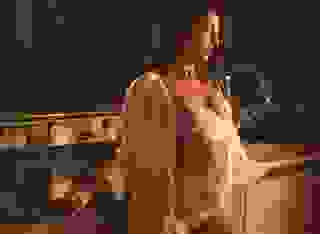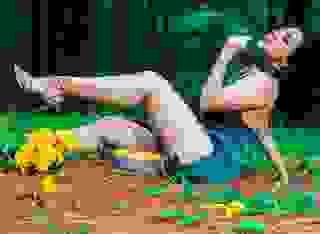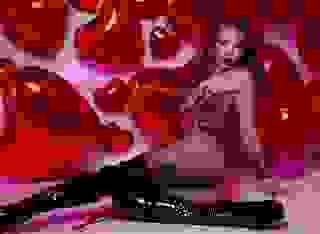- Mature
- The Cold Case that Turned Hot
Note: You can change font size, font face, and turn on dark mode by clicking the "A" icon tab in the Story Info Box.
You can temporarily switch back to a Classic Literotica® experience during our ongoing public Beta testing. Please consider leaving feedback on issues you experience or suggest improvements.
Click hereAs a short explanation for those who don't know, I'm Detective Richard Owens of the Knoxville, Tennessee Police Department. I cut my teeth in police work as a patrol officer and then as a homicide detective in the Nashville PD, and moved to my job in Knoxville after I met Rochelle Roberts.
Rochelle is a writer who writes mystery novels based upon real cases. She asked the Mayor of Nashville if she could work with a detective on a cold case as research for her next novel. She got assigned to me and together, we solved a murder case that was thirty years old. Rochelle has a different way of looking at things that helped us solve that case. I took her to dinner to celebrate and then took her back to her hotel room.
That night in her hotel room, we discovered we fit together in more ways than solving murder cases. After six months of driving back and forth, I applied for and got a homicide detective's job with the Knoxville PD. Rochelle and I live together but we're not married. We're thinking about it, but for now, we're content to live together and enjoy each other at every opportunity. Rochelle seems to need a lot of opportunities for us to enjoy each other, and I'm not complaining.
As I wrote before, if a murder case isn't solved quickly, it doesn't just get forgotten. There is no statute of limitations for the crime of murder, so those unsolved murder cases go into a detective's cold case file. The original detective will continue to investigate when he has time, as he has new ideas, or when new information or evidence comes to light.
If the detective hasn't solved that case before he leaves the police force, his case file gets passed on to another detective. I'd picked up this case file when the original detective, Harry Maxwell, retired in 2011.
It was almost 2:00 in the morning on September 10, 1992 when Harry got to the scene and all he could see was a gap in the guardrail at the tight curve on Delrose Drive on the north side of Knoxville. Still in the right hand lane with its emergency flashers blinking was a Kenworth W900 with some deep gashes on the heavy chrome bumper and with the lower part of the radiator grill mashed in a couple inches. The trailer behind the Kenworth was a lowboy loaded with some sort of industrial machinery.
When Harry walked over to the missing guardrail and looked down, a Chevy Suburban lay on it's top about thirty feet down and was burning so hot he had to step back. The fire department was already there and were hosing down the Suburban, but it wasn't doing much of anything because all they could do was spray water on the bottom of the car and not much was going inside it.
Harry talked to the two patrol officers who'd called the fire department and requested a detective. Harry didn't need to know why they'd called the fire department. A few trees next to the car were already beginning to smolder from all the heat. After a second fire truck pulled up, that crew started hosing down the surrounding trees and bushes in hopes of stopping a brush fire before it could get started.
What Harry needed to know was why the officers had requested a detective. When he asked Jack Montgomery, Jack frowned and said the truck driver said the car was just sitting there when he came around the curve. It wasn't moving and there were no lights anywhere.
Jack thought the driver was still in the car because they hadn't found anybody walking around and none of the doors or windows looked to be open. They couldn't come up with a logical reason why the driver would still be in the car unless he or she was already dead before the crash happened.
When Harry talked with the truck driver, he told Harry he came around the curve and there was a car sitting in the road. The truck driver said he tried to stop, but even though he was only running about fifty, his rig weighed almost seventy-eight thousand according to the scales when he left and there wasn't enough room for him to get the rig stopped.
What happened then is he hit the back end of the Suburban, and pushed it through the guardrail and down the embankment before he could get the rig to a complete stop. He backed up, turned on his emergency flashers, and then used his CB radio to get somebody to call the police.
What Harry found when a tow truck finally got the Suburban back up to the highway and turned over was two bodies, or what was left of two bodies.
As soon as Harry saw the bodies, he called the coroner and told the tow truck driver he'd have to wait until the bodies were removed. While they waited, Harry took the VIN number off the dash and the license plate number.
Morgan Davis, the coroner at the time, and the two EMT's he brought with him removed the bodies from the Suburban once the fire department guys had opened the doors. They ended up cutting the door pillars and door hinges off to do that since parts of the door locking mechanism were an aluminum alloy and the intense heat of the fire had melted them enough the door latches were frozen and wouldn't move.
Once Morgan had removed the bodies and left for the morgue, Harry told the tow truck operator to take the car to the police lab impound. He wanted a couple techs to go over the car to see if there was any evidence of a murder because Morgan had told him he also suspected the two passengers had been killed before the Suburban was hit.
Harry then went back to the station and ran the VIN number of the 1991 Suburban through the Tennessee DMV. It came back as registered to Victor and Rhonda McCabe who lived in a small subdivision east of Knoxville proper at 123 Blakemore Road. He then ran both names through the DMV records and found out Victor and Rhonda also owned a 1990 Mercury Grand Marquis. The descriptions on their licenses said Victor was forty-two and Rhonda was thirty-nine.
Once he had that information, he ran Victor McCabe and Rhonda McCabe through the county and Knoxville records departments.
What he was able to find out was that Victor and Rhonda were the owners of a house at 123 Blakemore Road. Victor McCabe owned a lawn care business and Rhonda McCabe was a real estate agent. Neither had any type of police record. According to the county birth records, they had two children -- Samantha McCabe and William McCabe. Samantha was twenty-one and William was eighteen. Both listed their addresses on their driver's licenses as the same as their parents.
Harry was working on the assumption that the two bodies in the car were Mr. and Mrs. McCabe since the Suburban was registered to them. He drove out that afternoon to talk to Samantha and William. He couldn't tell them their parents were both dead, but he could tell them that was a possibility and see how they reacted. He was thinking the same way I'd have been thinking. With most murders, the killer is someone the victim knows well, and immediate family members land at the top of the list until proven otherwise.
When Harry got to the house at about five that night, the daughter wasn't there. The son, William, was, so he talked to him. His first question was had William seen his parents that day and William said he hadn't. When Harry asked if that was unusual, William said it wasn't because they got up at six for their jobs and he'd slept in until nine because his first class at the junior college didn't start until ten. Then he asked Harry why he wanted to know that.
Harry didn't answer William because he knew what all detectives know. The murderer will usually try to find out what the police know so he or she can make up a story that includes that information and appears to eliminate them as a suspect.
Instead, he asked if maybe William's sister might have seen them. Again, the answer from William was no. His sister was a nurse at a local hospital and worked twelve-hour shifts from 7:00 PM to 7:00 AM. When Harry asked William where his sister was since it was after seven, William said she only had an associates degree in nursing and was at UT taking the final test to get her bachelor's in nursing. Then he asked Harry how he knew he had a sister and what was all this about.
Again, Harry didn't answer William. He just asked what kind of car his mother and father drove. William said his dad had a Chevy Suburban that he used to haul his lawn care tools and pull his trailer around and that his mother had a Mercury that he was using to go back and forth to class. He said his dad dropped his mother off at her real estate business and then went on to do the lawns he needed to do that day.
Harry asked William how his mother was able to take clients to see houses if she didn't have a car. William said the owner of the real estate agency let her use his Lincoln. Then William asked for the third time why Harry wanted to know, and Harry told him.
Harry told William there had been an accident that morning involving a Chevy Suburban and that the Suburban was registered to Victor and Rhonda McCabe. He said there were two victims inside the Suburban and that they hadn't been able to identify them yet because the Suburban had broken through a guardrail and then rolled down a steep embankment and caught fire. Harry asked William if there was a reason his parents might have been out on Delrose Drive late the night before and William looked shocked. He didn't say anything for a while, and when he did, Harry was suspicious that he wasn't getting all the truth.
Part of the reason for that was William didn't show much emotion at hearing his mother and father might be dead. The rest of the reason was what William told him. William said it was rare that they went out together, but once in a while they did. He said that the night before, his father seemed to be pretty happy and asked his mother if she'd like to go somewhere for dinner. They hadn't come home when William went to bed, so he assumed that's what they'd done and had probably stopped off for a drink on the way home.
When Harry asked William why he didn't go with them, William had frowned and said he didn't get along with his dad very well and hadn't since he could remember. William said his dad was a very controlling person who would let his sister get away with anything while he had to do everything like his dad said. As a result, he stayed away from him as much as possible.
Harry then asked William if he got along well with his mother and William just shrugged. He said she was OK as a mother, but since he was in junior college and she was gone so much showing houses to clients that he hardly saw her. Many people wanted to look at houses after they got off work, so sometimes she didn't get home until late in the evening.
Harry asked William what hospital his sister worked at, and William said she worked at the UT Medical Center. William asked if he should call her and tell her what happened, but Harry said that should come from a police officer and he'd drive to the Medical Center and tell her in person.
Harry talked with the daughter, Samantha, an hour later and her response was much different than William's. She got tears in her eyes when he told her about the accident and that he'd traced the Suburban as the same car owned by her father. She'd wiped her eyes with her hands then asked Harry when he'd know for sure. Harry said probably in a day or so. She said since she was twenty-one and the next of kin, she knew she'd have to take care of the funerals and asked Harry what she'd have to do to claim the bodies. Harry told her as soon as he had a positive identification and the Coroner was done, she could have a funeral home come to the police morgue and they'd be released.
That bothered Harry too. Most people would be really upset if they thought both their father and mother were dead. Samantha seemed to be upset, but more interested in what she'd have to do to get them buried than the fact that they might be dead.
What Morgan's autopsy showed was that the driver was a male. He couldn't make out any birthmarks or tattoos because there was almost no skin left on the body, but the man was wearing a heavy gold ring on his right ring finger that said, "Army Veteran" on the top and inside the band was stamped "VIC", all in capital letters.
Morgan said he didn't know if "VIC" was a name or something else, but he'd had his secretary look it up and it could mean "Veterans in Christ". That's all Morgan could really determine as far as identification, but Harry figured "VIC" was short for Victor, so the guy was probably Victor McCabe.
Morgan was positive the body in the passenger seat was female. When he x-rayed the bodies, he saw three small dark spots in the lower abdomen of the passenger's body. When he retrieved them, they turned out to be the copper parts of an IUD and Morgan also confirmed that she had a uterus and ovaries.
He told Harry the organs were deep enough inside the body they weren't totally burned, and by the look of her ovaries, she was still fertile. That would put her age at less than fifty and her pelvis showed signs she'd had at least one child so she was probably older than twenty-five or so. He said she wasn't wearing a wedding ring, but his techs found one diamond and gold earring when they sifted through what was left of the carpet on the floor of the Suburban.
Morgan couldn't trace the IUD because there wasn't enough left, but told Harry the copper IUD's weren't introduced until 1984 so it had to be implanted after that. He'd taken pictures of the earring and the ring the man wore.
Morgan had also changed his mind about the victims being killed. He'd seen a small hole in both skulls, a small hole just behind her left temple and one on the man's right temple that looked like a bullet hole would probably look if it hadn't been burned so badly. He couldn't make that determination with any certainty because of two things.
The primary reason was the techs didn't find a gun in the car or anywhere down the embankment. If the driver shot the passenger and then shot himself like it appeared to Morgan at the scene of the accident, the gun should have been in the car or would have fallen out on the trip down the embankment or when the tow truck pulled it back up.
The techs had combed that area with metal detectors and had only come up with a couple of beer cans. He also couldn't find a bullet in either skull. Morgan explained that if there was one, the fire was hot enough it would have melted the bullet but it still would have shown up as a clear trace on an x-ray.
The other reason was because his techs had found the metal parts of two claw-like hand weeders in between the front seats. The handles had been burned away, but the round tines on both fit the holes in the skulls. The three tines were far enough apart that if one did punch the hole, the other two probably wouldn't have hit anything and left a mark. Morgan also said he found other holes in both skulls that he figured were punctures made by contact with the weeders when the Suburban rolled over going down the embankment. The female also had some broken bones in her face that Morgan attributed to the fact that she evidently hadn't been wearing a seat belt and had probably been hit by some of the gardening tools in the car as the car rolled down the embankment.
Morgan said he'd taken tissue samples from some soft tissue and bone from both bodies and had sent smaller samples of them to the TBI to try to get a DNA analysis. He wasn't holding out much hope though. He said from what he'd read about DNA, as much heat as the bodies were exposed to probably destroyed any DNA.
He also said he couldn't call either a murder with any reasonable probability, so he'd have to certify both causes of death as the accident. He said he had no idea why they'd have been sitting out there with the car not running or why the fire was so intense, but he didn't have any provable medical reason that it wasn't just an accident. All he needed before writing his final report was the names of the victims. After that, he'd release the bodies to the next of kin.
Harry told Morgan the two names on the vehicle registration and Morgan said he'd get his secretary to start making calls to all the gynecologists in the area about the IUD. An hour later, Morgan called Harry and told him his secretary had confirmed that Mrs. McCabe had requested an IUD from a Doctor Mitchell, and he'd implanted a copper IUD in her uterus in August of 1985.
Morgan also had more medical history on Mrs. McCabe. Doctor Mitchell had installed a Dalkon shield in Mrs. McCabe's uterus shortly after her son was born. He removed it six months later because of the warning from the FDA that the device wasn't safe. He'd then prescribed birth control pills to her that she continued to take until she read about the new copper IUD. Harry didn't think that information told him anything except that he was nearly certain it was Mrs. McCabe in the morgue.
Harry took the pictures of the earring and the ring and showed them to William. William said the earring was one of a pair his grandmather had given his mother on her thirtieth birthday, and the military ring was one his Dad had worn since he could remember.
Harry drove back to UT and showed the pictures to Samantha who also verified that the earring and military ring belonged to her parents. Harry then told Samantha that the coroner was ready to release the bodies. The next morning, the McMullen funeral home called for both bodies at the morgue and Morgan released them.
When Harry handed the case file to me, I asked him why he'd kept the file since technically, it was a closed case. He just shrugged and said it was a gut feel that something went on out there that night besides two people getting pushed down an embankment by a semi.
He told me were too many things that didn't make sense then and a couple that didn't make sense after that. For one, and he didn't find this out until after she'd claimed both bodies, Victor had an insurance policy for half a million and Samantha, not Rhonda, was the beneficiary.
He also thought it was suspicious that Samantha had both bodies cremated instead of buried. Harry tried to get in touch with her about that, but her brother said the day after they were cremated, she took both boxes of ashes, told the brother the house was his, and that she wasn't coming back because she couldn't live there anymore.
Harry called the hospital to talk to her and they said she'd quit and didn't tell anybody where she was going. Since Morgan had listed the cause of death for both as an accident, Harry couldn't spend time or department resources in continuing the investigation officially, but he did try to find the daughter on his own.
The brother had no idea where she went and told Harry she wouldn't have told him anyway because they didn't get along very well. Harry did start again once the social media sites started up on the Internet, but he never found a woman named Samantha McCabe.
When Harry gave me the file, he smiled at me and said it was my headache now. He grinned then and said that maybe my sexy lady and I could find something he couldn't and asked if we did to let him know. Unfortunately, Harry had a heart attack two years later and died.
I took the file home with me that night and gave Rochelle a shorter version of the case and asked her if she was interested in looking at it. I couldn't really do anything because it wasn't an open case.
Rochelle listened to everything and then looked at the file while I went outside and mowed the grass. When I came back into the house, she was looking at the pictures of the accident. She looked up and frowned.
"I think I agree with Harry. I don't think this was an accident. I mean, I understand why the coroner made the decision he did, but like Harry told you, there are too many things that don't make sense.
"How was it the car was stalled at the exact place to hide it from anybody coming around the curve without seeing them until it was too late to stop? I might write that into a novel, but I don't think it could happen in real life. It's like whoever killed them knew that exact spot and left the Suburban there so it would get hit and look like an accident.








